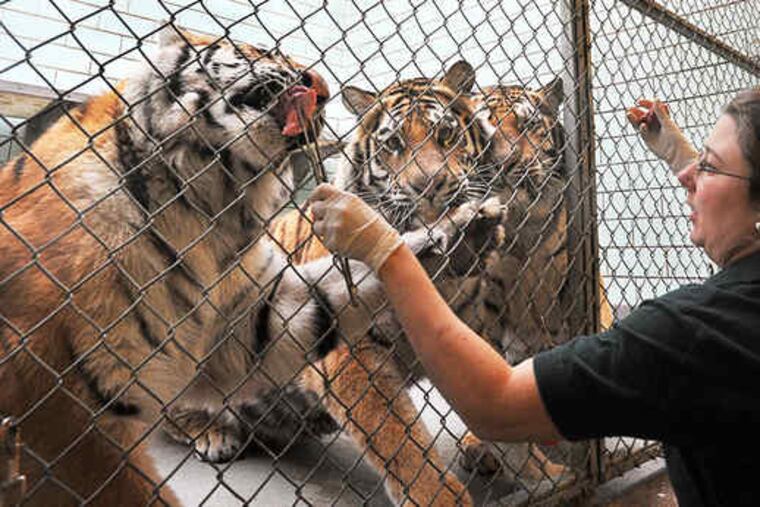Zoo cuts costs, but not 150th-birthday plans
When it comes to ventures with quirky expenses, this one is a doozy. Imagine caring for 1,300 charges, all with dietary restrictions. More than a few go only for beef, up to 20 pounds a week. A handful drink blood. Meals: $500,000 a year.

When it comes to ventures with quirky expenses, this one is a doozy.
Imagine caring for 1,300 charges, all with dietary restrictions. More than a few go only for beef, up to 20 pounds a week. A handful drink blood. Meals: $500,000 a year.
Even served their favorite dishes, some of this crew can be pretty surly. That, and the fact they have more than a million visitors a year, means few breaks on liability insurance. Cost: about $800,000 annually.
And check out the water bill: $2.8 million. That's what happens when you're stuck with old, leaky facilities and guests who like to swim.
Those expenses represent just some of the annual red ink at the Philadelphia Zoo, America's oldest zoological park and among the region's favorite nonprofit attractions.
While the zoo is more exotic than your typical enterprise, it is still a business, and money coming in has to cover money going out.
With that in mind, the zoo's managers have been particularly conservative in planning for the coming fiscal year, which includes a big birthday - 150 - and a yearlong party.
Rest assured, says Vikram Dewan, the zoo's president, enough trims have been made to balance the budget and keep the party on track.
There was little magic to it: wage freezes for most employees, up to 10 percent salary cuts for some (including Dewan), positions left unfilled, and trims to discretionary spending.
The trims offset about $1.1 million of, it is hoped, worst-case in projected revenue loss for the coming year, said Joseph T. Steuer, the zoo's chief financial officer.
Some things not done to balance the budget: layoffs or cuts to party plans.
"A celebration marking a 150th anniversary takes years to plan," said Amy Shearer, chief marketing officer for the zoo. "None of it is going to be compromised."
Finding money was not easy.
The zoo has seen some serious erosion of the plus side of its balance sheet, starting with its endowment, which has dropped from $25.5 million to $17 million.
At the same time, corporate donors and out-of-town visitors have become scarce.
Corporations make up about 15 percent of the zoo's donors, a group that covers about 20 percent of the $25 million operating budget and all of the $12 million to $15 million annual capital budget.
Visitors from outside a 100-mile radius of Philadelphia represent about 10 percent of zoo guests, but a larger percentage of income, given they spend more freely than locals on souvenirs and food.
"This is a high-margin group," Dewan said.
As those funds fell off, the zoo was hit with rising health-care costs. And the city, with its own financial troubles, said it would begin charging for water.
As noted above, the zoo uses $2.8 million worth a year. Dewan said the zoo was negotiating with the city over the bill. It hopes to convince the city that, as an attraction that drives tourism and provides free access for many city schoolchildren, it deserves credit for its contributions.
One reason water usage is so high, according to Andrew J. Baker, the zoo's chief operating officer, is the age of the facility. It is filled with buildings and exhibits designed long before much consideration was given to water conservation.
Many past and present aquatic features - including Bird Lake - were designed to use free-flowing water, rather than closed systems, Baker said.
Since 1993, the zoo has been methodically replacing these open systems, he said, reducing its water use 25 percent so far.
The water bill was just one of the concerns as Dewan and his managers prepared a budget for the coming fiscal year.
It was a daunting exercise, given the current economic climate.
In the end, Dewan said, they fashioned a conservative document that assumed about a 3 percent drop in revenue, factoring in inflation.
Even against a slumping economy, the plan is for the fun to continue, zoo employees to keep their jobs, and the animals to enjoy their stay.
That means beef for the big cats and blood for the vampire bats.